Visiting Bunratty Castle Ireland – 800 years of history
Bunratty Castle in Ireland is high on the Irish bucket list for visitors and locals alike. The imposing Castle can see seen just off the motorway and it is undoubtedly one of Ireland’s most loved castles. The Castle itself was built in the 15th century and your visit includes the 19th-century Folk Park.
The 15th-century restored Bunratty Castle in County Clare, Ireland was believed to be originally a Norse settlement that was destroyed by Brian Boru in the 900s.
Where is Bunratty castle located? Bunratty Castle is located just off the N18 Limerick/Ennis Road – just ten minutes from Shannon Airport. It’s very easy to spot from the highway and you will see Durty Nellies’ beautiful bright yellow building with Bunratty Castle rising above it.
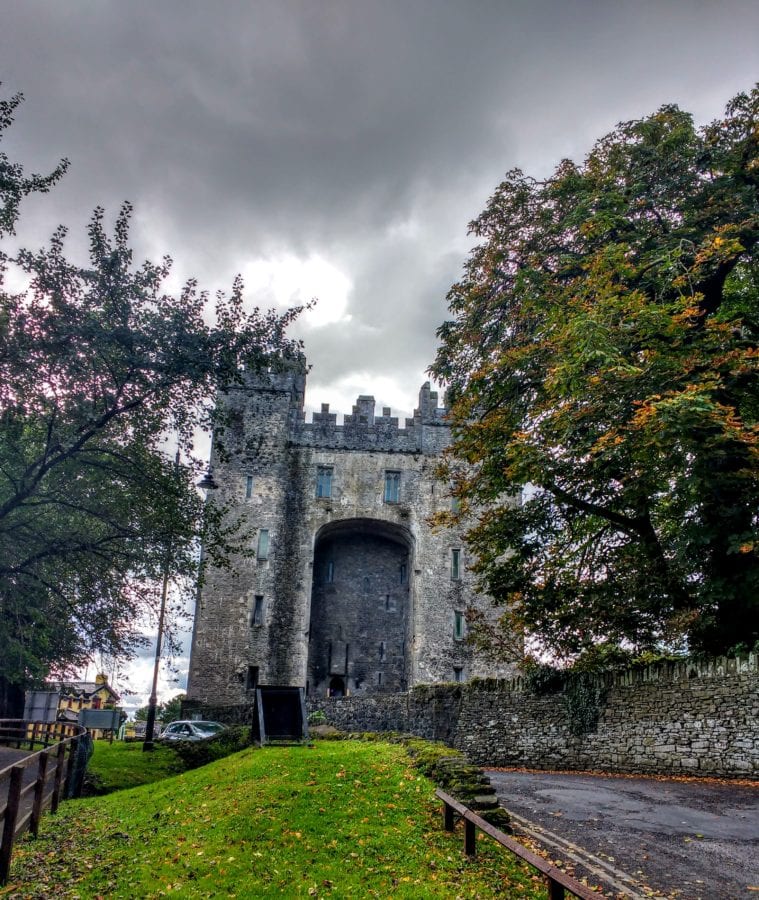
Xyuandbeyond is reader-supported. When you buy through links on our site, we may earn an affiliate commission. You can read my privacy policy here.
Planning a dream trip to Ireland? Everything you need to know
Where is Bunratty Castle?
From Dublin: Railtours Ireland operate a one-day tour from Dublin to Bunratty Castle & Folk Park, The Cliffs of Moher, The Burren and Galway Bay. Railtours schedule here.
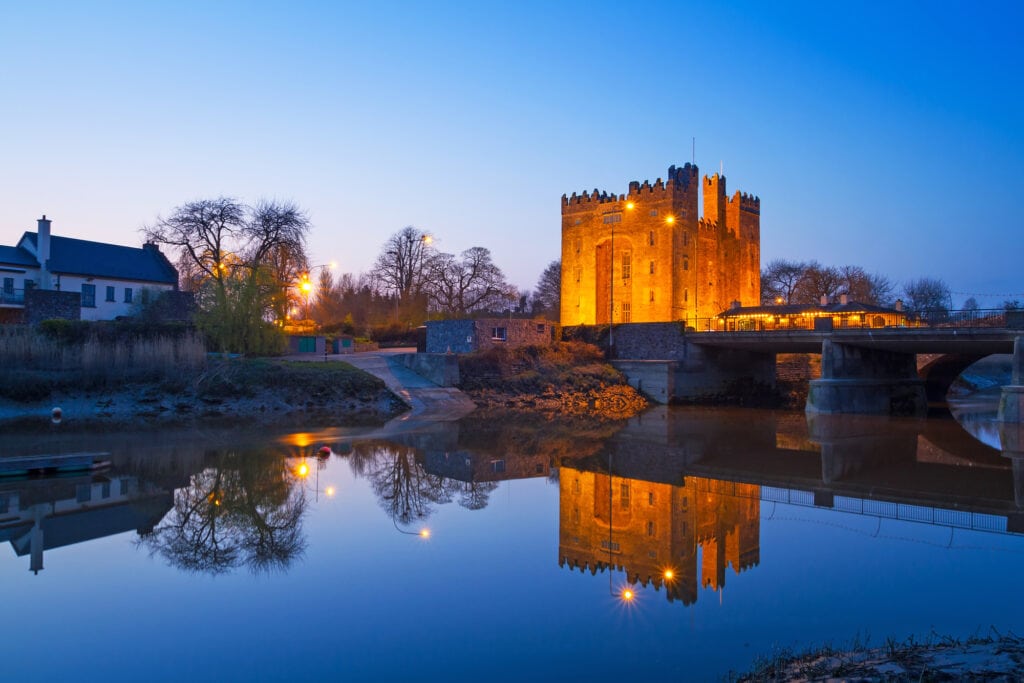
53 Ultimate Ireland travel tips
Bunratty Castle from Dublin
To get to Bunratty from Dublin you can drive there in about 3 hours but it’s a bit of a journey. If you are in Galway, it takes just over an hour to get there.
You can also get to Bunratty by train and bus. The bus service takes around 3-5 hours and the train considerably less.
From Dublin, you would take the train to Limerick and when you get off the train, the bus depot is right next door so you can grab the bus to Bunratty directly from there. You could also take a taxi to Bunratty but that’s gonna cost you.
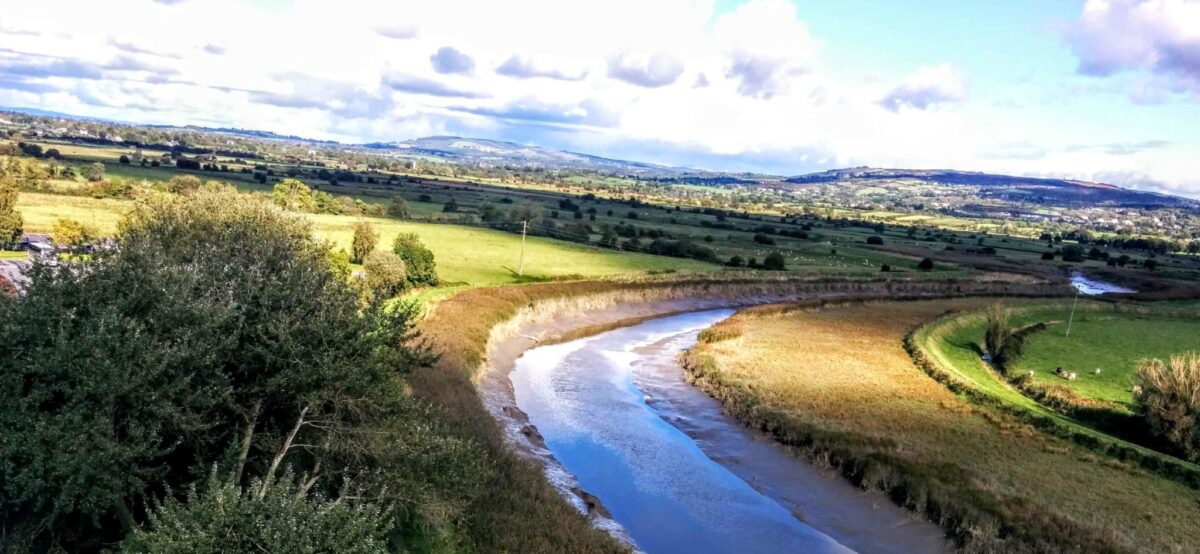
Bus Eireann will take around 4 hours and the Dublin City Coach will take around 3 hours or so. The cost for the Coach averages around €22 Euros and Bus Eireann is a 4-hour plus journey at a cost of €35 Euros. Either of these buses drops you at the stop and the walk to Bunratty is around 10 minutes.
Xyuandbeyond is reader-supported. When you buy through links on our site, we may earn an affiliate commission. You can read my privacy policy here.
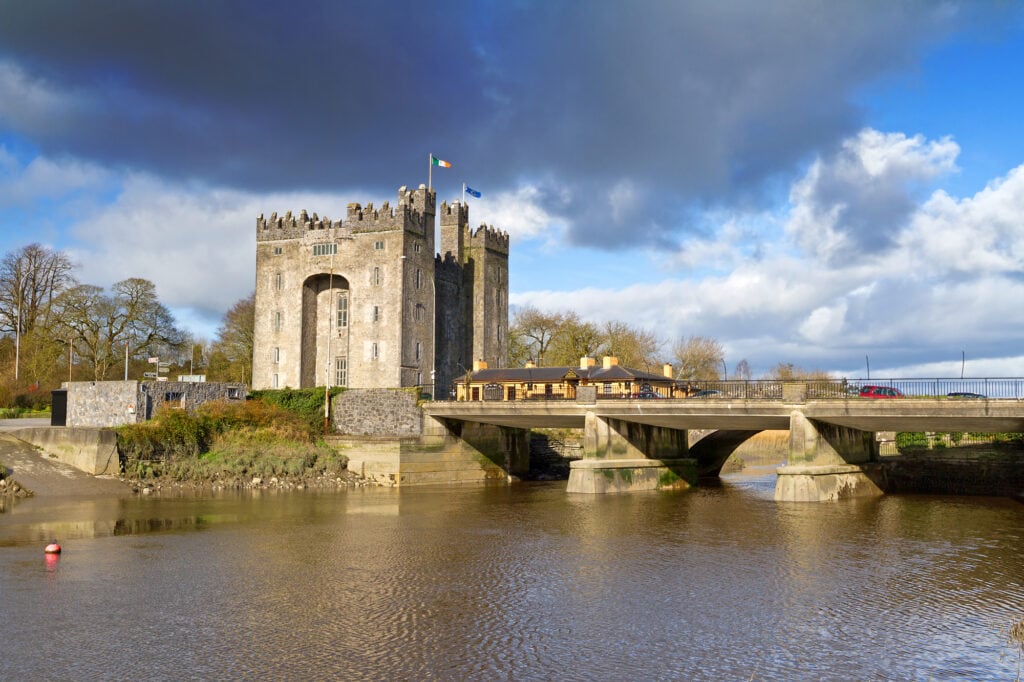
History of Bunratty Castle
Bunratty castle history says that the first invaders to settle at the Shannon Estuary were the Vikings. At the end of the 10th century AD, they established a trading settlement where pirates and looters brought their captured (stolen) prizes for trade and exchange. Since Viking times the location near the Shannon estuary had been seen as a strategic point. They were followed by the next wave, Norman invaders in the 13th century.
During the 1200’s King Henry III granted the lands of Bunratty to Thomas De Clare a descent of Strongbow. It was De Clare who built the first stone structure on the site. This castle was a simple stone tower and it stood near the river probably very close to the existing site.
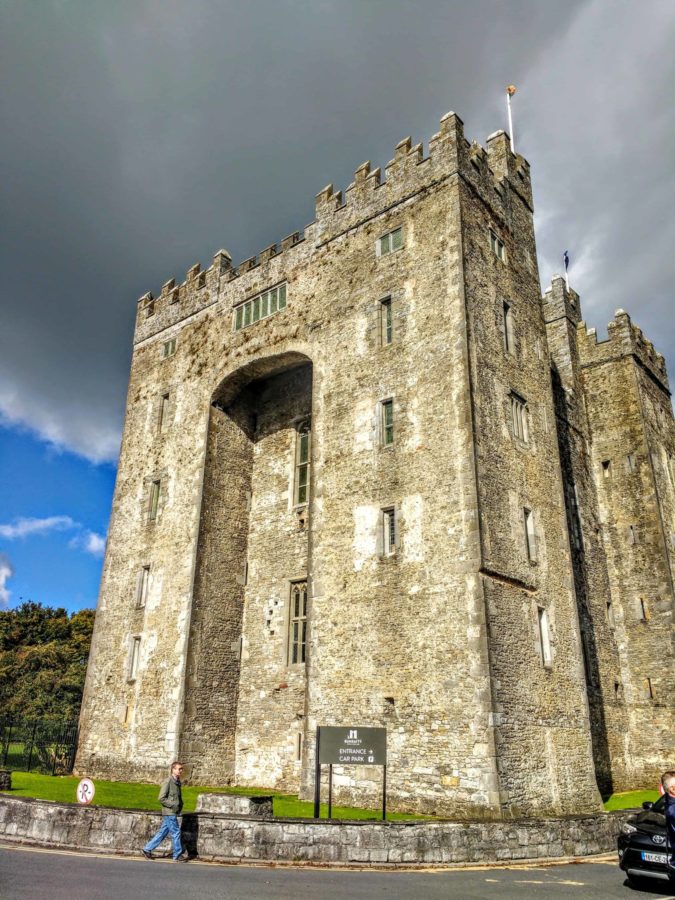
In the late 13th century, the lands around Bunratty had a population of around 1000 people. The castle itself was attached by the O’Brians several times and was finally destroyed when De Clare was in England Being a stubborn man De Clare had the second Castle rebuilt with a long narrow moat or fosse as it was known in those days.
The castle was attached a few more times and fell again in 1318. During a major battle, De Clare and his son Richard were killed and his wife Lady De Clare burnt the castle down so nobody could take it and fled to Limerick. The family never returned to Bunratty and soon the existing castle collapsed into ruins.
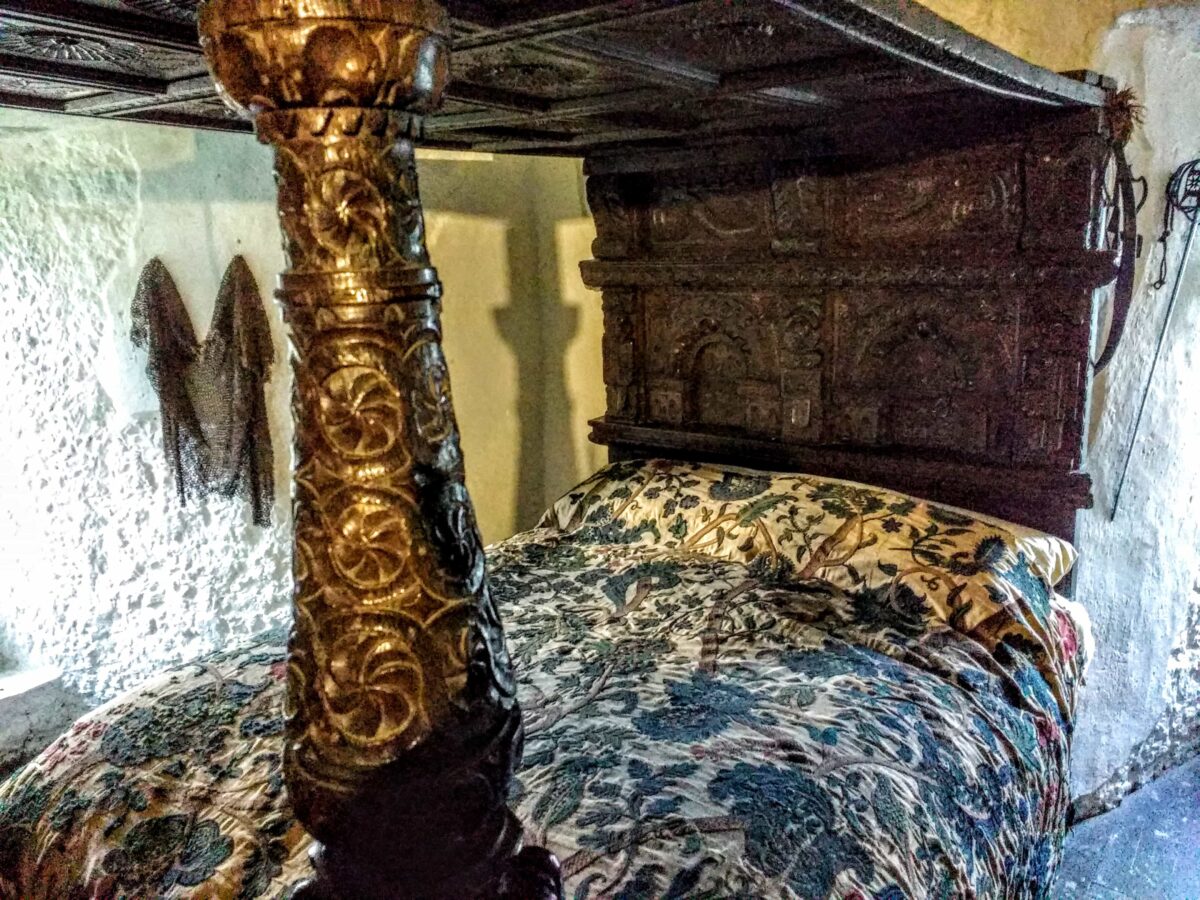
Several more owners came and went and there was even a third version of the castle, which went to ruin.
In 1646, during the Irish Confederate Wars, Barnaby O’Brien, the Earl of Thomond, allowed a large English Parliamentary garrison to land in Bunratty. The castle was besieged and taken by the forces of Confederate Ireland under Donagh MacCarthy, Viscount Muskerry. When Barnaby, or Barnabas O’Brien, 6th Earl of Thomond, left Bunratty for England in 1646 for his own safety, during the Confederate wars, he was the last member of the O’Brien Clan ever to reside in Bunratty Castle.
Inside Bunratty castle which was purchased by Viscount Gort in 1956 and fully restored with the help of the Irish Government you can visit various rooms. The new castle at Bunratty was opened to the public in 1960 and included furniture, paintings, tapestries and works of art dating back to the 1600s.
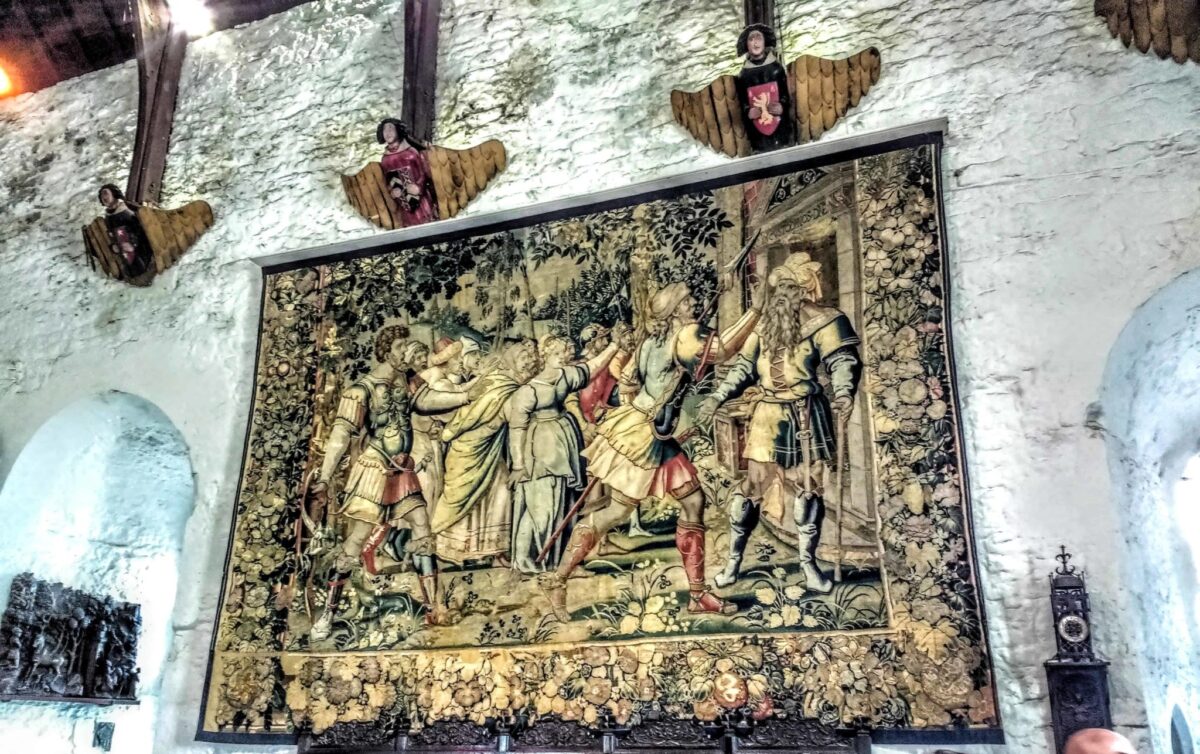
Today, everyone wants to see Bunratty Castle and take in the adjacent Bunratty Folk Park. The castle is famous for its medieval banquets, which include the Bunratty Castle Entertainers and a fine 3-course meal.
Explore the 19th-century folk park which is an open-air museum featuring around 30 buildings, including the Ardcroney Church of Ireland, which moved here and reopened in 1998.
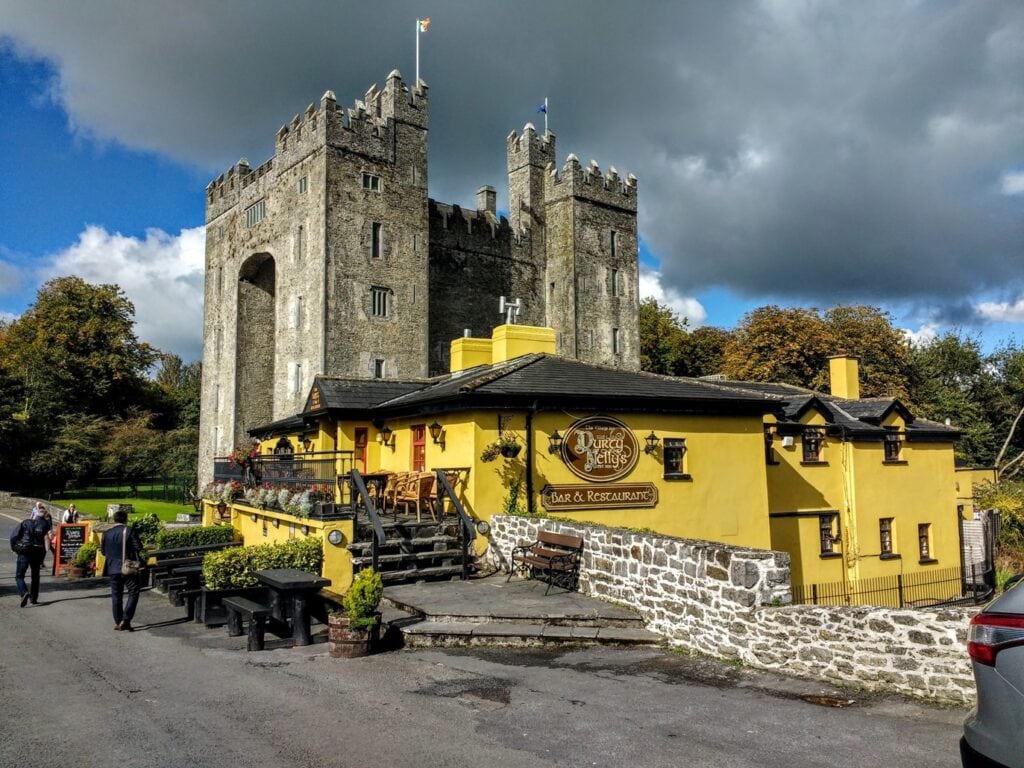
Essential guide to renting a car in Ireland
Tickets for Bunratty Castle
How much are the tickets for Bunratty Castle? The Castle and Village cost is €15.00 per adult and €9.00 per child and that covers the full experience of the castle and village but not the medieval banquet.
Admission is all year round. 9:00am- 5.30pm. Please be aware that the castle closes daily at 4 pm to prepare for the Bunratty Castle medieval banquet.
Bunratty Castle showcases one of the finest collections of medieval furniture in Ireland. You can trek all the way up to the roof where you will see spectacular views of the area. The rooms are filled with a collection of artefacts from the late medieval to the renaissance period and include rugs, tapestries, clothing, furniture, tools, art and weaponry.
Magical Places in Ireland to see

Durty Nelly’s Pub
If you are driving to Bunratty Castle, you will see Bunratty off the main highway as it can’t be missed. Right beside the Castle, you will see from the motorway is a bright yellow building.
This is Durty Nelly’s and it is one of Ireland’s most famous pubs and offers a truly unique Irish experience through its history and character. Often copied but never replaced this truly unique piece of Irish heritage dates back to 1620. Enjoy the craic here in the pub where there’s live Traditional Irish music seven nights a week and festivals all year.

The history of Durty Nelly’s is an intriguing one. The Durty Nelly whom the venue is named was once the keeper of a toll bridge over the river Owengarney. The full history involves a rogue and a thief from Kilrush, stolen gold coins, a dream about poteen, an Irish Wolfhound, a miracle cure, the establishment of the Shebeen (a place that sells “the drink” but not legally), and fame forevermore.
Durty Nelly’s is one of Ireland’s most famous pubs and offers a truly unique Irish experience through its history and character. Legend has it that Nelly herself introduced Poteen to Ireland.
Durty Nelly’s offers some great affordable meals, excellent pints and a well-pulled Guinness. There is live music every week and you can even learn to pour your own Guinness at the bar.
Nelly’s Blessing
May the road rise up to meet you. May the wind be always at your back. May the sun shine warm upon your face, the rains fall soft upon your fields and until we meet again, may God hold you in the palm of his hand.
Bunratty Castle Medieval banquet
The Bunratty Castle Banquet is one of the most famous events in Ireland a raucous night of medieval revelry and food that takes place over 2 hours and a bit. The cost of the Bunratty Medieval dinner is around €63 per adult but reviewers say it is well worth it.
The Banquet is quite the experience, upon arriving at the Castle a kilted piper, pipes you over the drawbridge where the hostesses who offer you the “bite of friendship” greet you. You then enter the Great Hall with its beautiful tapestries, long oak tables and benches where you can have a goblet of traditional Irish mead.
The history of the Castle is relayed by the storytellers and is followed by a medieval madrigal. The Earl and his Lady are crowned before descending to the Banquet Hall, which is lit by candlelight, and their guests await.
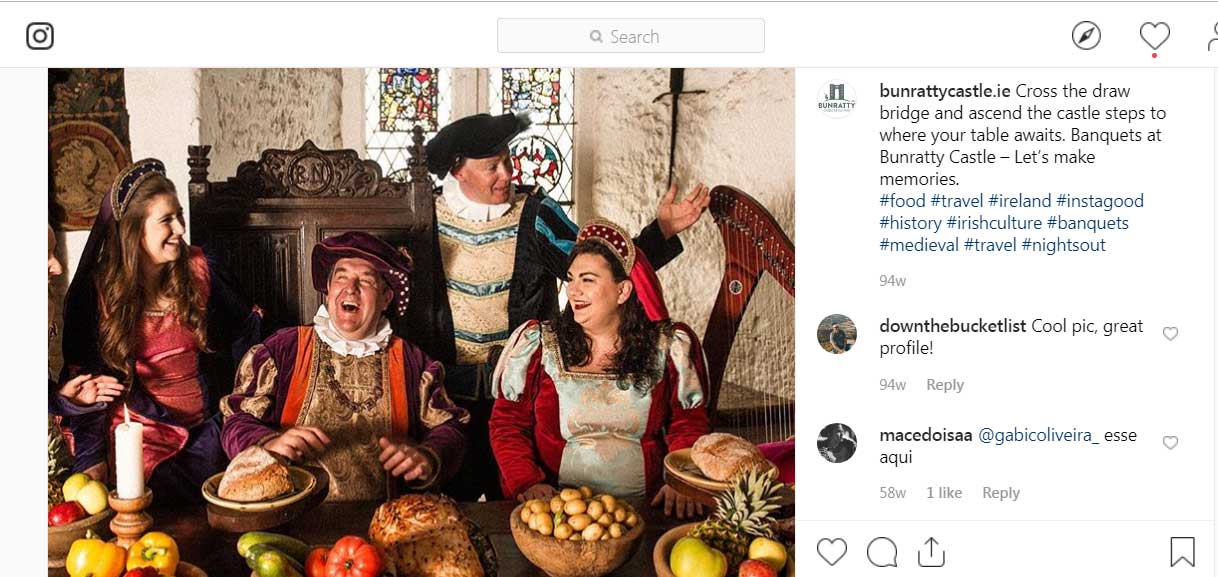
The Banquet itself is a four-course dinner with wine accompanied by music from the Ladies of the Castle with harp and fiddle. The menu includes Spiced Parsnip Soup, Spare Ribs, Roast Chicken, locally grown vegetables and a lovely Apple pie for dessert and yes, there are vegetarian options.
The entire evening is a fantastic romp back to medieval times with scoundrels, butlers, Ladies and ancient music. There are two seating’s night and reservations must be made.
Ultimate Wild Atlantic Way Route
Bunratty Castle and Folk Park
Visiting the Bunratty Folk Park is a real treat, set over 26 acres this amazing park includes over 30 buildings, a living village and a rural setting. There is a children’s play area, Gypsy caravans, and a Fairy Village. Your tickets for Bunratty Folk Park are included in the entry fee.
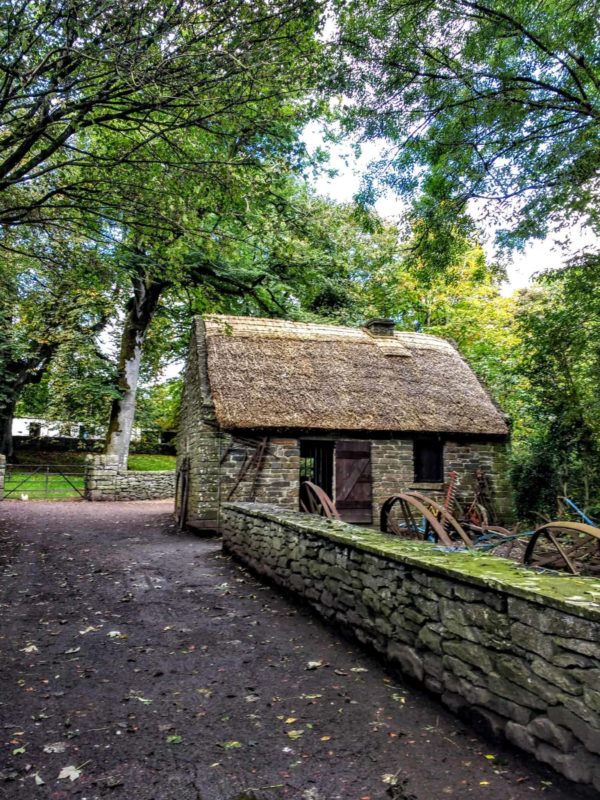
Costumed interpreters replicate the lifestyle and recreate traditions from days gone by at Bunratty. These animators are well known in the park and include the Bean a Ti (woman of the house), the Royal Irish Constabulary Police, a schoolteacher, and various assorted other animators from spinners to blacksmiths to pub landlords.
Bunratty homes include village shops, the poorest of rural homes, country cottages and fine Georgian residences. The Georgian home was built in 1804 for the Studdarts who were the last family to occupy Bunratty Castle.
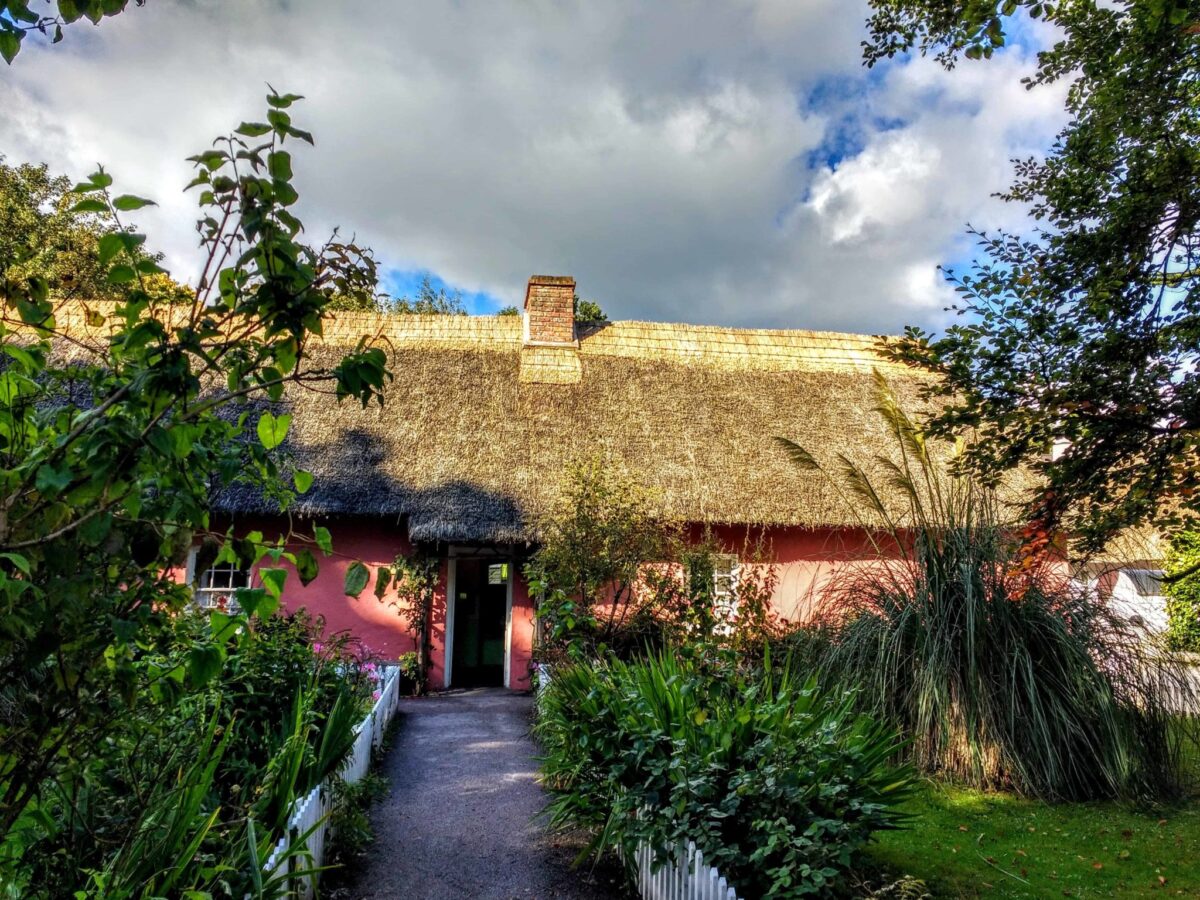
The village houses and shops at Bunratty have been chosen from many different areas, to form a collection of typical 19th-century urban Irish buildings including the School, Doctor’s house, Pawnbrokers, Pub, Drapery, Printers, Grocery, Hardware shop, Pottery and a Post Office.
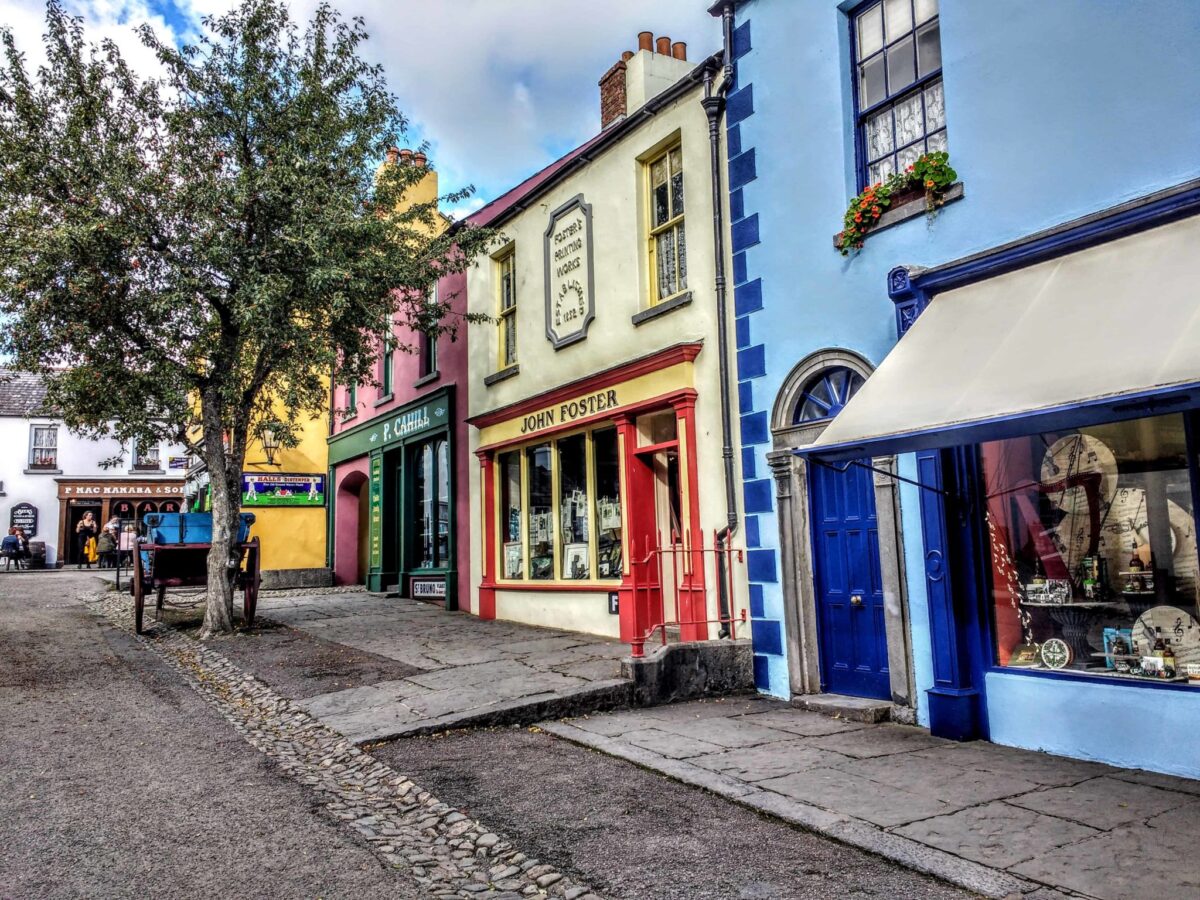
MacNamara and Sons, which sits at the top of the village street, is a fully licensed working pub so feel free to drop by and have a pint. Many of these old pubs were not only licensed for a drink but they were the only grocery and hardware stores in the area.
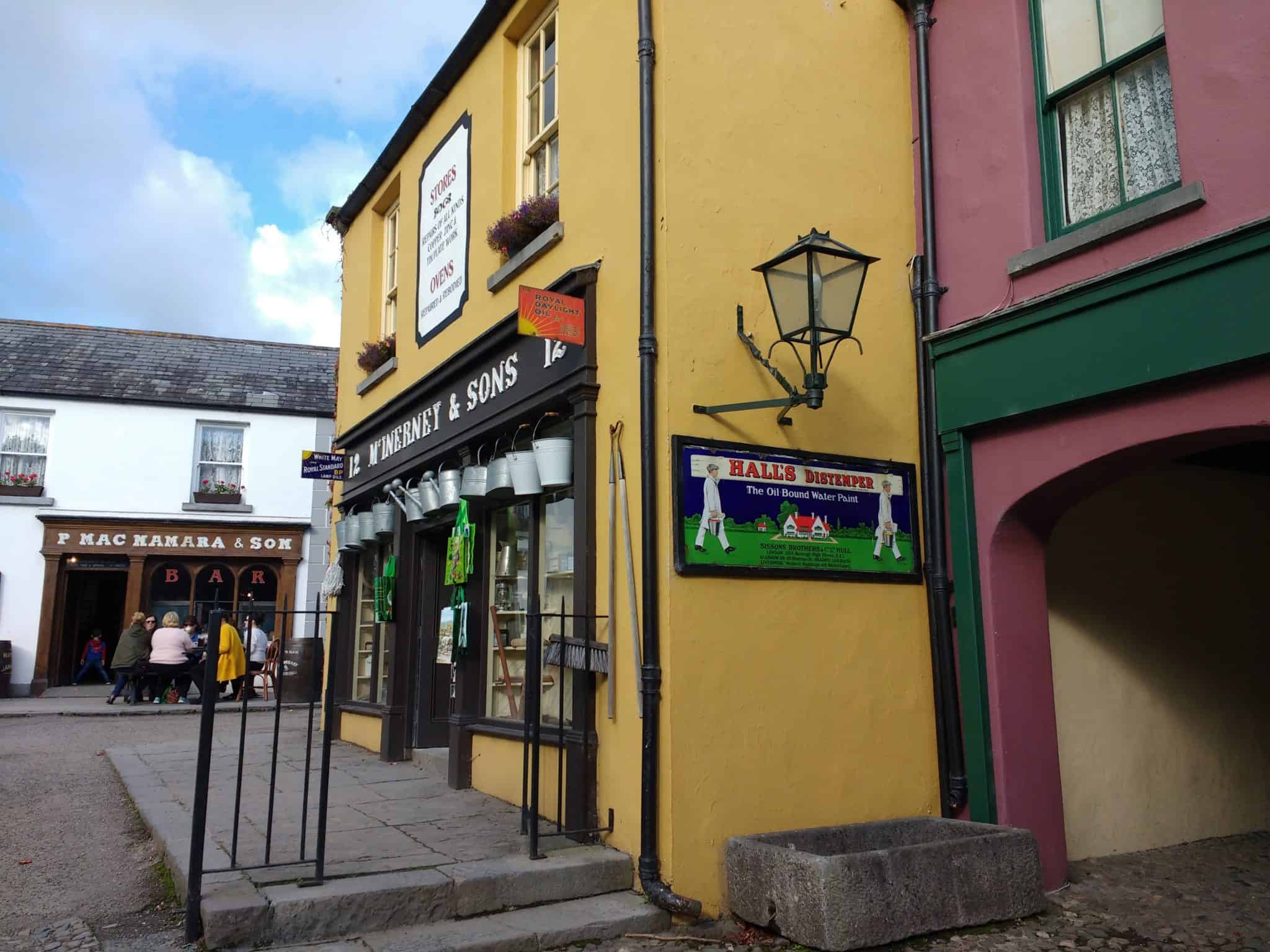
Bunratty Fairy Village
The Fairy Village at Bunratty Castle is a very recent discovery. Located in a very pretty section of woodland these magical beings have gone undiscovered for hundreds of years.

The fairy people welcome visitors into their village but are notoriously shy and may not always appear themselves! Explore the fantastic new willow tunnel and willow hut in the surroundings of the magical forest trail.
Bunratty House Walled Garden
Don’t miss the beautiful walled garden at Bunratty House. It is a surviving part of the demesne which was originally formed around Bunratty Castle. The garden was built in 1804. It is small, just less than half an acre, this was due to the fact that a large garden would have existed within the demesne, located north of the castle.
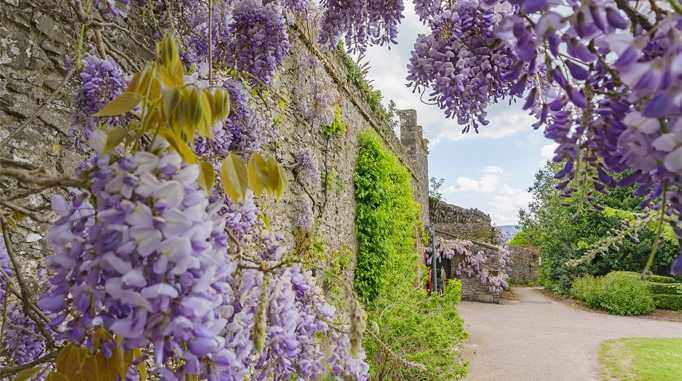
This walled garden was built in a protected area on the east side of the house. The walls are the only things remaining of the original gardens, but they have been extensively restored to their Regency Splendour. With help from a local grant, all of the gardens in the Bunratty Folk Village have also been restored to portray the plants and land use of the period. This is probably one of the few Folk Villages in Ireland that has accurately depicted and restored the horticultural heritage of Ireland.
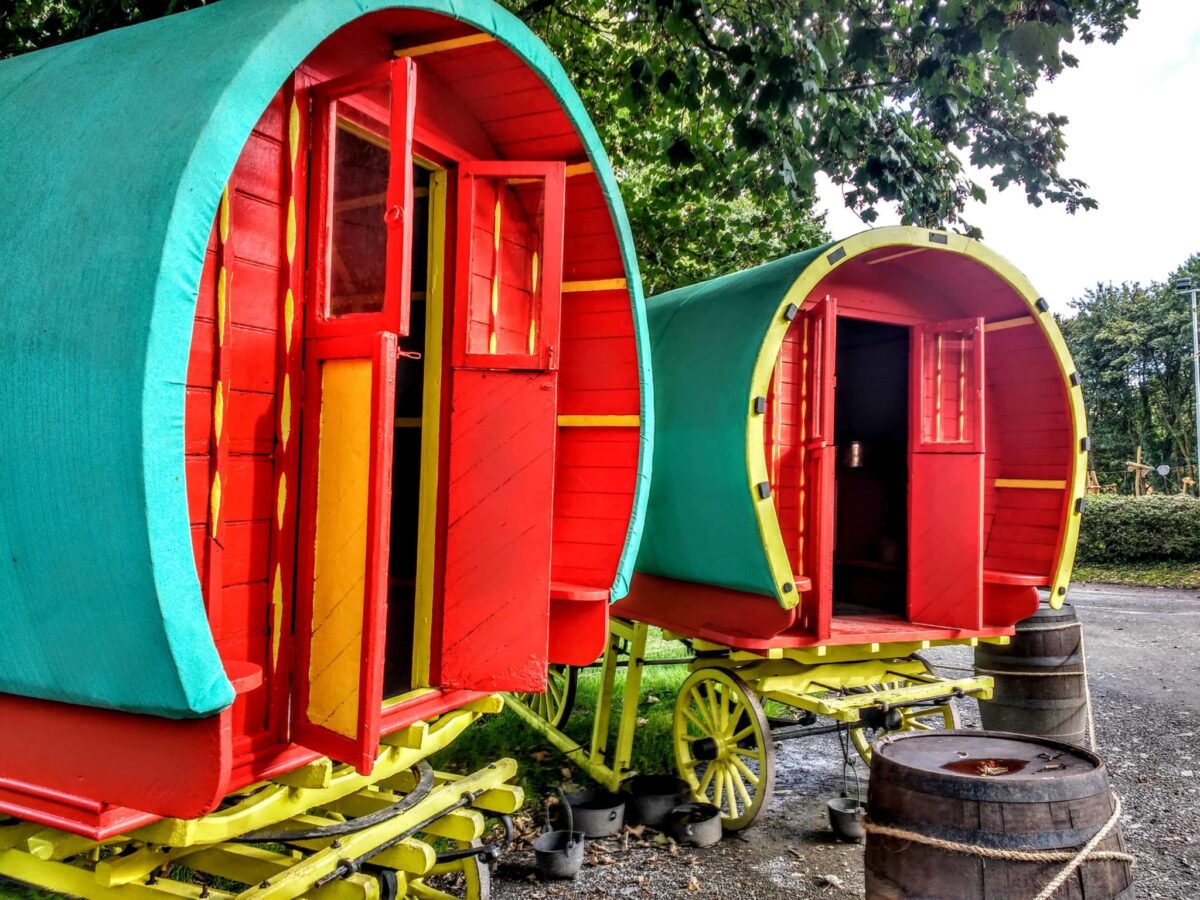
Facts about Bunratty castle
Bunratty Castle Hotel
Bunratty Castle Hotel is virtually next door to Durty Nellies pub (a bonus) and only a 10-minute drive from Shannon Airport where you can rent a car and drive to the hotel. There is an indoor heated pool and a gorgeous spa. Each spacious room has satellite TVs, free internet and 24-hour room service. You can pamper yourself with the hot tub, gym and steam room with a wide variety of massage and beauty treatments. Don’t pass up a chance to have a great meal at Fibber McGee’s Steakhouse or a drink at Kathleen’s pub.
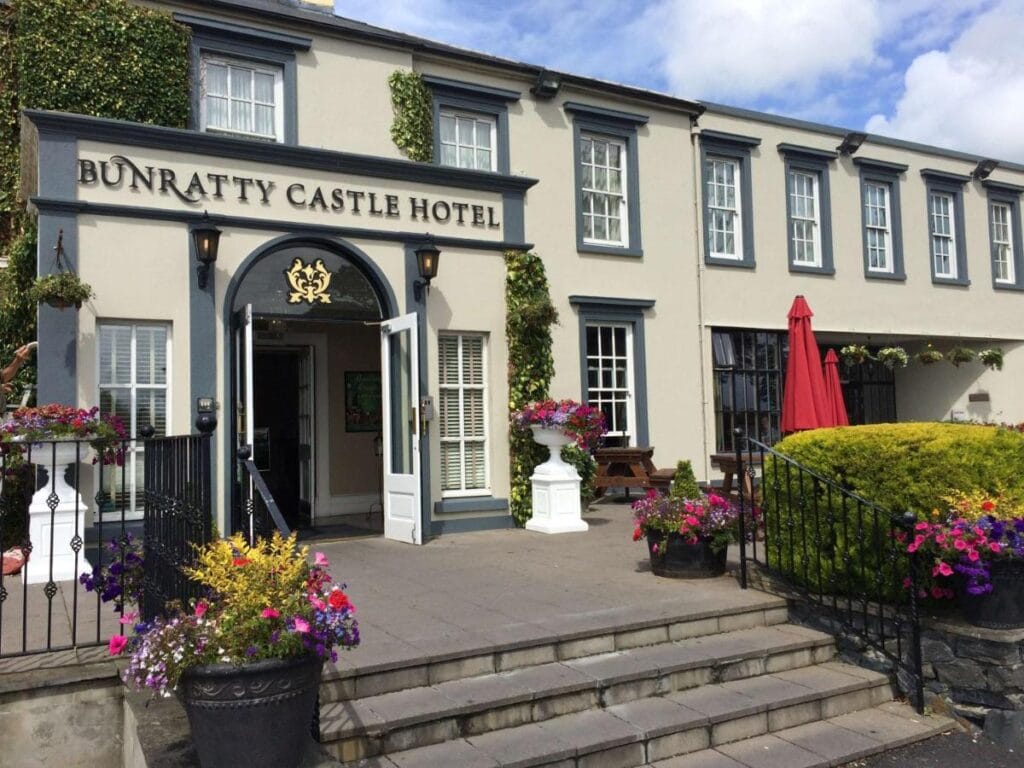
If you are looking for great accommodation in the area be it hotels, hostels or B&B’s don’t forget to check out the huge selection at booking.com.
Remember the Shannon Heritage area also has some amazing other sites to visit when in the area. King John’s Castle, Malahide Castle, and even the haunted Dunguaire Castle. Don’t forget about Birr Castle in Offaly it has magnificent grounds and a 19th-century telescope to view the stars.
Have you been to Bunratty? What did you think? I would love to hear what folks thought of the Medieval Banquet as I couldn’t afford it myself…lol..
Interested in more castles in Europe?
